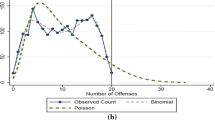Abstract
It has become a criminological fact of life that a small group of offenders is responsible for a far greater share of offending than its size would suggest. For example, it is well known that in the 1945 Philadelphia birth cohort, 6% of the cohort members committed 52% of the offenses. We argue, however, that the conventional percentaging approach to measuring skewness in offense distributions is inadequate. We propose and apply an alternative approach to measuring offense skewness which utilizes the offense distribution to its fullest and can easily and meaningfully be used for comparisons across or within study populations.
Similar content being viewed by others
References
Alker, H. R. (1970). Measuring inequality. In Tufte, E. R. (ed.),The Quantitative Analysis of Social Problems, Addison-Wesley, Reading, Mass.
Alker, H. R., and Russett, B. M. (1964). On measuring inequality.Behav. Sci. 9: 207–218.
Blumstein, A., and Moitra, S. (1980). The identification of “career criminals” from “chronic offenders” in a cohort.Law Policy Q. 2: 321–334.
Blumstein, A., Cohen, J., Roth, J. A., and Visher, C. A. (eds.) (1986).Criminal Careers and Career Criminals, Vols. I and II, National Academy Press, Washington, D.C.
Farrington, D. P. (1981). Longitudinal analyses of criminal violence. In Wolfgang, M. E., and Weiner, N. A. (eds.),Proceedings of a Workshop on Interdisciplinary Approaches to the Study of Criminal Violence, Sage, Beverly Hills.
Hamparian, D. M., Schuster, R. S., Dinitz, S., and Conrad, J. P. (1978).The Violent Few: A Study of Dangerous Juvenile Offenders, D. C. Heath, Lexington, Mass.
Peterson, M., Braiker, H., and Polich, S. (1980).Doing Crime: A Survey of California Inmates, Rand Corp., Santa Monica, Calif.
Shannon, L. W. (1980).Assessing the Relationship of Adult Criminal Careers to Juvenile Careers, U.S. Government Printing Office, Washington, D.C.
Tracy, P. E., Wolfgang, M. E., and Figlio, R. M. (1985a).Delinquency in Two Birth Cohorts, Executive Summary, U.S. Department of Justice, Washington, D.C.
Tracy, P. E., Wolfgang, M. E., and Figlio, R. M. (1985b).Delinquency in Two Birth Cohorts, Final report submitted to National Institute of Juvenile Justice and Delinquency Prevention, U.S. Department of Justice.
Visher, C. A. (1986). The Rand inmate surveys: A reanalysis. In Blumstein, A.,et al. (eds.),Criminal Careers and Career Criminals, Vol. II, National Academy Press, Washington, D.C.
Wolfgang, M. E., Figlio, R. M., and Sellin, T. (1972).Delinquency in a Birth Cohort, University of Chicago Press, Chicago.
Wolfgang, M. E., Thornberry, T. P., and Figlio, R. M. (eds.) (1987).From Boy to Man;From Delinquency to Crime, University of Chicago Press, Chicago.
Author information
Authors and Affiliations
Rights and permissions
About this article
Cite this article
Fox, J.A., Tracy, P.E. A measure of skewness in offense distributions. J Quant Criminol 4, 259–274 (1988). https://doi.org/10.1007/BF01072453
Issue Date:
DOI: https://doi.org/10.1007/BF01072453




